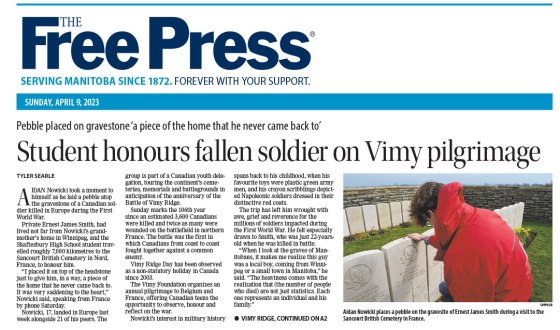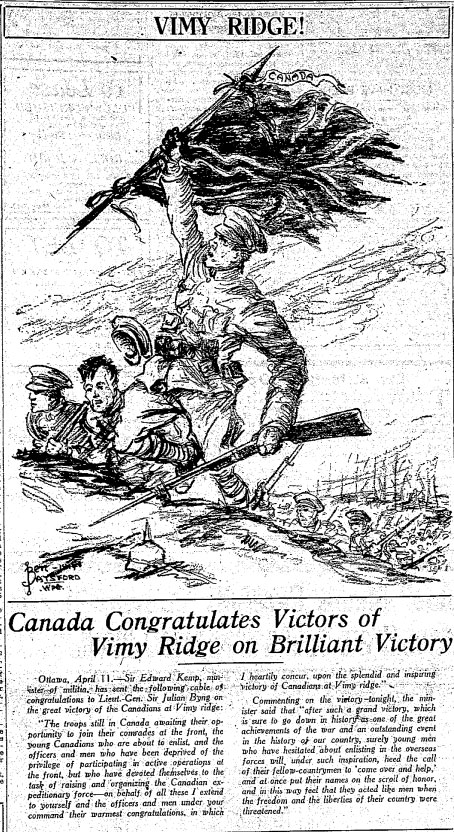|
On Easter morning, I finally cracked open a book that has languished on my to-read list for longer than I care to admit.
The reason I began that long-awaited read of Tim Cook’s Vimy on April 9 was deliberate. On that fateful day 106 years ago, Canadian soldiers went over the top and began the battle and legend that’s the subject of his national bestseller.
The Canadian Corps were able to take Vimy Ridge in just four days, far faster than I’ll get through the 394 pages of Cook’s book. But I already had in motion another way to honor the 10,000 Canadians killed or wounded in that epic battle.
Advertisement
 Why this ad? Why this ad?
On the front page of our Sunday e-edition, I ran a story about a high school student from Winnipeg who is in France for a Vimy pilgrimage. Aidan Nowicki had taken a pebble from Winnipeg to place on the gravestone on Pte. Ernest James Smith, who had called Silver Heights home.

“I placed it on top of the headstone just to give him, in a way, a piece of the home that he never came back to. It was very saddening to the heart,” Nowicki told reporter Tyler Searle.
Vimy has been front page news in the Free Press since the first shots of the battle. On our April 10, 1917 edition, the headline across the top of the page screamed: CANADIANS STORM FAMOUS VIMY RIDGE.

The front page of the Winnipeg Free Press, April 10, 1917.
Over the four days of the battle, Vimy was a constant on the front page until the celebratory headline announced: CANADIANS CLEAR ENEMY FROM LAST POSTION ON RIDGE.
The subhead was a nice exclamation point on that victory: “Enemy had orders to hold positions at all costs but were unable to withstand attack of Canadians.”

From the front page of the Winnipeg Free Press, April 12, 1917.
In his book, Cook delivers more than a tribute in his retelling of the Vimy story.
“The capture of the seemingly impregnable ridge by Canadians from all regions is a built-in unity story,” Cook writes.
“Vimy has been described as a key event in Canadian history, even the origin of the modern country, but what that means in (now) is different from what it meant in 1992 or 1967, in 1936 or 1917. Vimy’s meaning has shifted with each generation, but it has usually been an important symbol.
“The Vimy idea is admittedly not universally accepted. Our heroes and legends are rarely all things to all people. Canada is a country – like most – that places little stock in history, teaching it badly, embracing it little, feeding it only episodically.
“As Canada developed over time, we cast aside much that grounded us in the past; yet there are some ideas and myths and icons that persistently carry the weight of nationhood. Vimy is one of them.”
I take some pride that part of Cook’s research to get the history of Vimy right included drawing on the Free Press, in particular the writings of the legendary John Dafoe who sat for 43 years in the editor’s chair.
I also take comfort that on the 106th anniversary of Vimy, a 17-year-old like Nowicki was on that famous ridge learning about its history – rather than being part of it, as would have been the case in 1917 when so many Canadian teens and young men were marching across its killing field.
|

